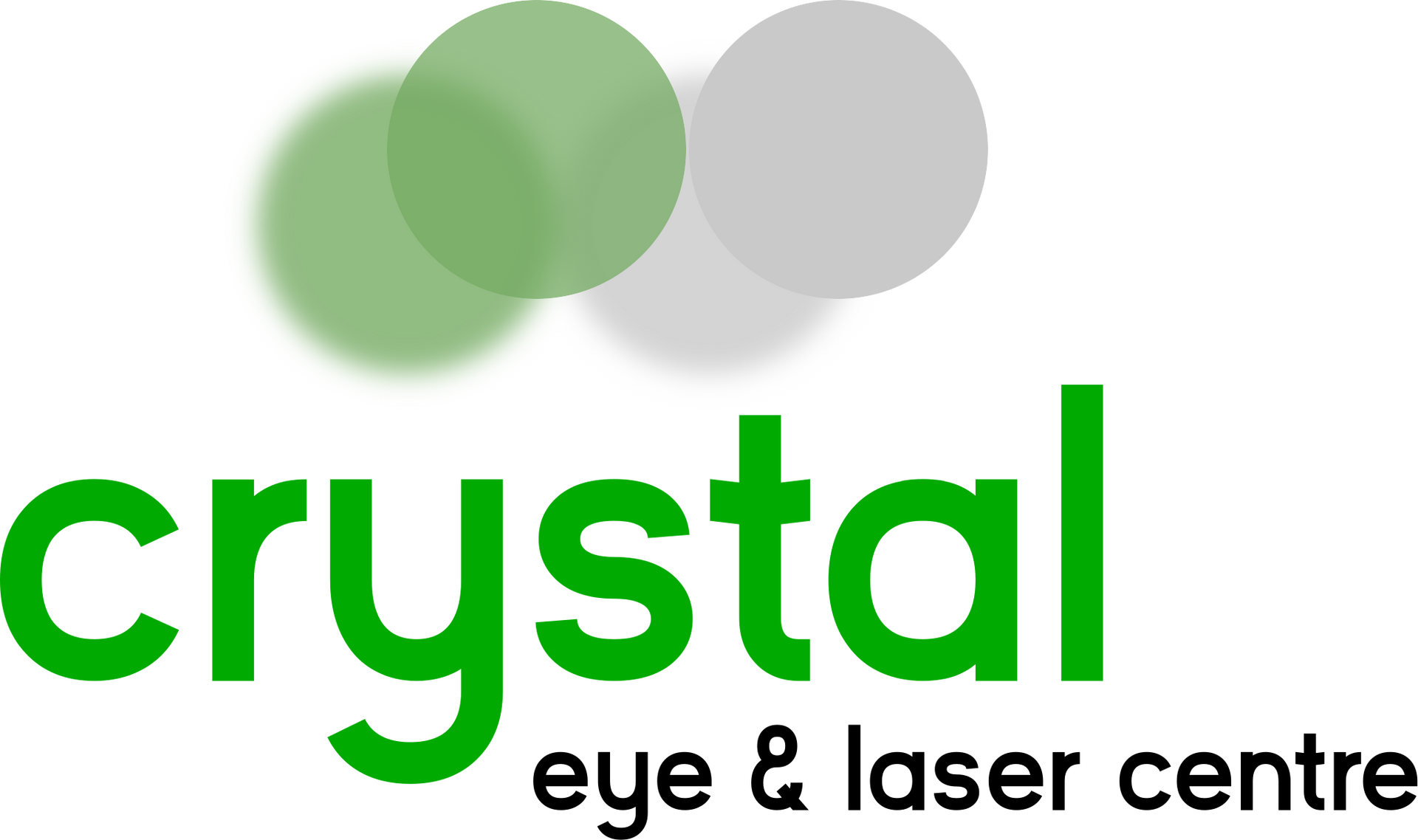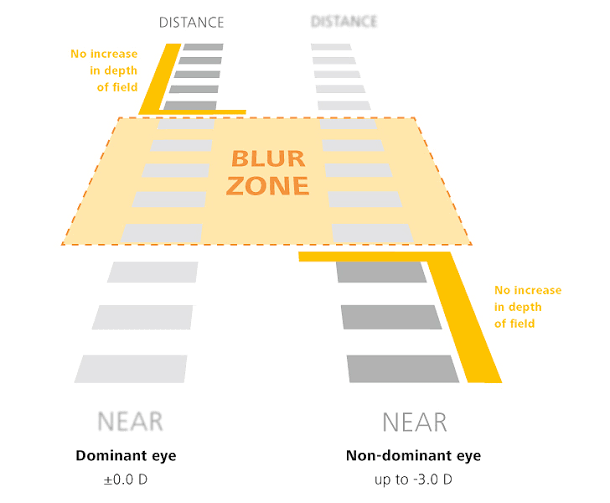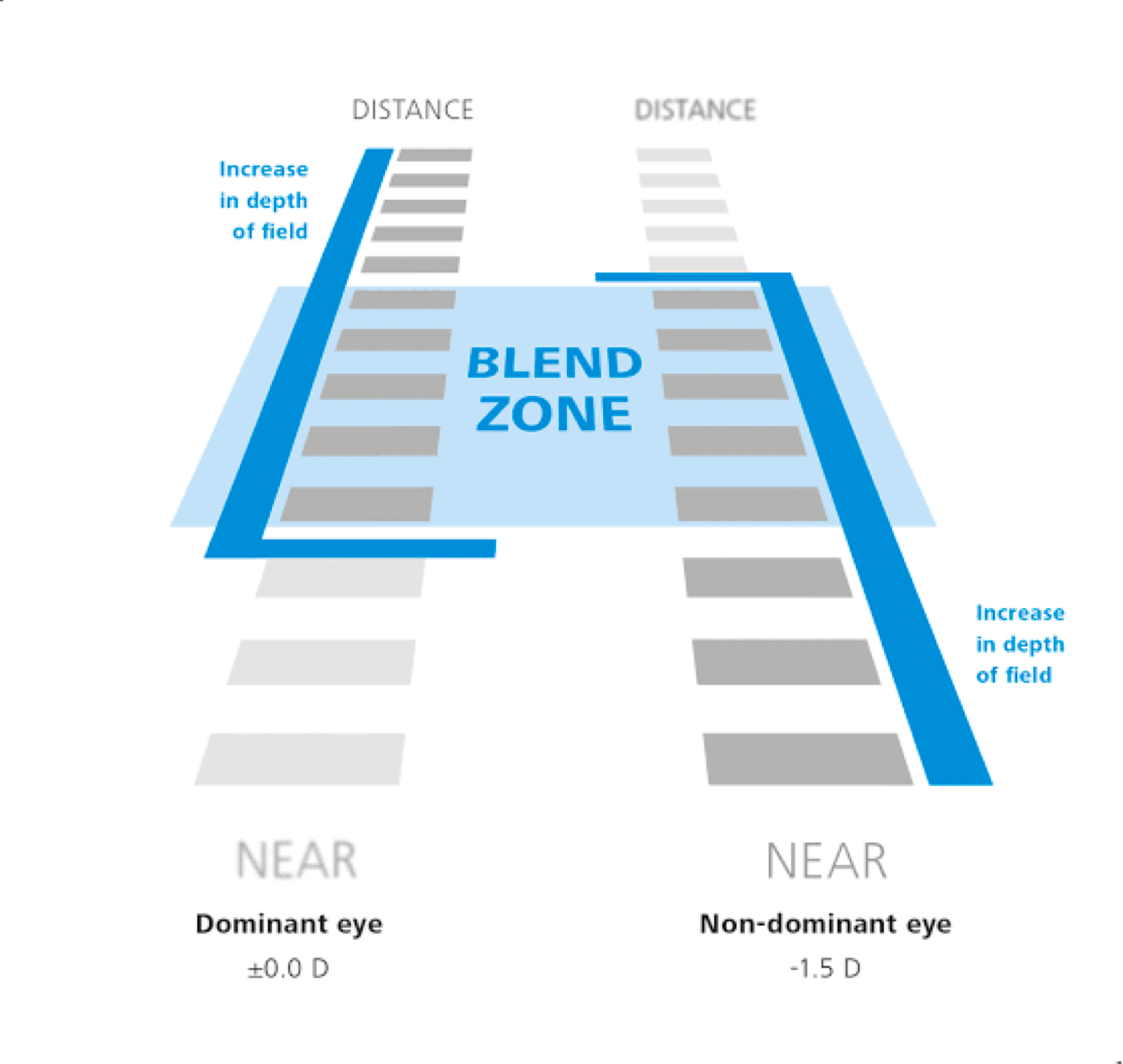Understanding Presbyopia
Presbyopia is the natural regression of vision with age that usually begins at the age of 40 and older. Similar to a camera lens, the cornea and lens of the human eye bundle the light rays and focus them at a focal point on the retina, resulting in a sharp image that is transmitted to the brain. The lens of the eye can change shape to focus on objects at different distances. As we age, the lens becomes less flexible and starts losing its ability to change shape and to adjust its focus. As a result, we have difficulty seeing sharply at all distances and eventually require reading glasses or contact lenses.
Through the increasing inflexibility of the lens and other biomechanical changes within the eye, the light rays from close objects cannot be focused on the focal point of the retina. As a result, objects at a short distance appear out of focus.
Presbyopia can occur in conjunction with other refractive errors such as nearsightedness, farsightedness, astigmatism and even normal vision. Fortunately, at Crystal Eye and Laser Clinic, we can help people with presbyopia to achieve vision in focus at all distances.
What is Presbyond Laser Blended Vision?
Laser Blended Vision is a sophisticated optical modification that compensates for presbyopia, the natural aging of the eye. Laser Blended Vision is performed as a LASIK procedure in the same way, the difference is it is designed to address both your distance vision and near vision together. In Laser Blended Vision we intentionally correct the eyes slightly differently: one is corrected to see clearest at distance with continuous focus into intermediate, the other eye is corrected to be clearest up close at a normal reading distance with continuous focus into intermediate where it overlaps or ‘blends’ with the intermediate vision of the other eye.
This means that with both eyes open, which is our normal state, the patient experiences a continuum of good vision from a normal near working distance, through intermediate distances, all the way to far distance.
Laser Blended Vision is the most effective method possible for correcting both the distance and near vision.
Is Laser Blended Vision right for you?
Laser Blended Vision is especially well suited for people with a very busy and active lifestyle who often find that reading glasses are not convenient enough.
Laser Blended Vision is effective for treating patients with presbyopia who also have other refractive errors like myopia, hyperopia or/and astigmatism.
In order to find out if Laser Vision Correction is right for you, your personal vision requirements and expectations are important factors. That is why you will have to answer questions about your hobbies, your daily activities and other aspects that might affect the decision.
As Presbyond Laser Blended Vision is customized for each patient, you will also have to undergo a detailed eye examination. The nature and degree of your refractive error(s), curvature and thickness of the cornea, as well as many other factors play a role. Your tolerance level for monovision and ocular dominance will also be tested.
Your eye surgeon will then personally advise you as to whether a treatment with Laser Blended Vision is right for you.
Presbyond Laser Blended Vision at a glance
01
Age-optimized Laser Vision Correction for people with presbyopia
02
Based on an established LASIK treatment
03
True binocular vision thanks to the unique Blend Zone
04
Generally vision in focus at all distances: near, far and even intermediate
05
Customized approach – individual treatment profile for each patient
Benefits and advantages of Presbyond Laser Blended Vision
- Clear vision from near to far
- Dependence on glasses is significantly reduced and in most cases patients do not need glasses at any range.
- Reading without reading glasses
- 97% of people are suitable for Presbyond Laser Blended Vision
- Presbyond can be CUSTOMISED to the individual requirements of a patient
- No glare and haloes at nighttime
- No loss of depth perception
- No loss of contrast sensitivity or quality of vision
- Presbyond is completely reversable either with laser eye surgery or glasses
- The surgery is non-invasive
- There is no risk of going blind
- There is no risk of retinal detachments
- There is no risk for infections inside the eye
- There is no loss of the remaining focussing ability of the eyes as the lenses are not removed. This further enhances the effect of Presbyond.
Laser Blended Vision
Presbyond Laser Blended Vision offers a variety of extra advantages – specifically, customized treatments that result in vision in focus at all distances. Laser Blended Vision represents the next stage in eye care excellence. Similar to monovision methods, one eye is primarily corrected for distance vision, while the other eye is corrected for near vision. However, there is a significant difference: it uses your binocular vision by fine-tuning the depth of field of each eye individually, creating a customized fusion of the two images in the intermediate zone – the Blend Zone.
The unique Blend Zone makes it easier for the brain to maintain its binocular vision by merging the images of both eyes for your normal 3D vision. Most patients experience an immediate improvement. They are able to adapt faster to their new eyesight. In addition, the procedure is tolerated by the vast majority of patients – up to 97 % as compared to only 59 – 67 % for monovision. Another huge advantage of Laser Blended Vision is that it maintains contrast sensitivity and preserves stereo-acuity very well.
Who are good candidates for Presbyond Laser Blended Vision?
- Patients that are older than 40 years needing readers or multifocal glasses
- Patients with busy and active lifestyles not wanting the hassle of reading glasses
- Patients with corrected vision of 20/20 or better
- Patients with healthy and normal eyes
- Patients with realistic expectations in regards to vision correction
- Patients that are suitable to undergo LASIK
How does Presbyond Blended Vision work?
- The laser corrects both eyes and induces a range of vision using standard LASIK
- One eye is corrected for mostly for distance and a little for near
- The other eye is corrected mostly for near and a little for distance
- There is an overlap of vision between the 2 eyes known as the “Blend Zone”
- Following the surgery the patient has continuous vision from near, intermediate to far ranges
- Presbyond does require brain adaptation and most patients are fully adapted by 4 months post-surgery
- The brain compensates for the slight difference in both eyes almost instantly, combining the two images to give much greater depth of vision, and an all-round improvement in visual acuity that means most patients can throw away those infuriating reading glasses
- Presbyond maintains the quality of vision (known as contrast sensitivity) of an eye
- Because of the “Blend Zone” the patient maintains depth perception unlike in mono-vision
Most conventional surgical as well as contact lens treatment options – use the archaic principle of monovision. This is where one eye is corrected for distance only and the other eye for near vision only. There is no “Blend Zone” and the brain must then suppress the image in one eye to seeing at different distances. Unfortunately, some patients are unable to get used to the procedure and only 60% of people are suitable for mono-vision. Patients frequently experience an area of blurred vision in the intermediate range – the blur zone. Those patients that can tolerate the procedure often require some form of spectacle correction at either intermediate or near ranges.
In contrast, Laser blended vision offers a variety of extra advantages – specifically, customised treatments that result in sharply focused vision at all distances. With this technique, we treat one eye to view objects mainly at a distance, but a little up close, and we treat the other to view objects mainly up close, but a little at a distance due to the extra range that is induced by the laser. Due to the “Blend Zone” the brain can fuse the two different images from both eyes together which enables the patient to see distance and near seamlessly. In most cases, the brain can compensate, and you will experience an excellent depth of focus and overall visual acuity, without the need to wear glasses or contact lenses. It is very rare that we might suggest a pair of specialised glasses for occupation specific duties.
The unique blend zone makes it easier for the brain to maintain its binocular vision by merging the images of both eyes for your normal 3D vision. Most patients experience immediate improvement.
Presbyond is NOT mono-vision
Most conventional treatment methods – surgical treatments as well as contact lenses – use the principle of monovision: one eye is corrected for distance and the other eye for near vision. The brain must adjust to seeing two images corrected for different distances. Unfortunately, a number of patients are unable to get used to the procedure.
According to scientific studies, only about 59 – 67 %1 of them can successfully merge the two images. Patients frequently experience an area of compromised vision in the intermediate range – the Blur Zone. Those patients that are able to tolerate the procedure often require some time to adjust to their new eyesight.
While the theory behind PRESBYOND® Laser Blended Vision is similar to that of monovision, it has several of advantages. In monovision, one eye is corrected for distance vision while the other is corrected for near vision. This can be done with the use of contact lenses or through laser correction. No range is induced and there is no overlap of vision or a “Blend Zone”.
Because of a lack of a “Blend Zone” , a monovision correction leaves a bigger gap between the range of vision of each eye. The depth of field is comparatively smaller than that provided by Laser Blended Vision. Essentially, instead of a blend zone, monovision can often create a blur zone. This gives either poor near or intermediate vision and in most cases glasses are still needed.
Presbyond induces spherical aberrations in Laser Blended Vision to increases the depth of field of each eye. Spherical aberrations are natural optical phenomena that all humans have in their eyes. This reduces the difference between the 2 eyes significantly, increasing tolerance, and providing continuous good vision from near through intermediate, to distance vision. All this is done using standard LASIK surgery which optimises both patient satisfaction and surgical safety.
Presbyond Laser Blended vision steps
Presbyond Laser Blended vision is achieved by using a standard LASIK technique. The overall healing time is exactly the same as standard LASIK but there is an added adaptation phase of about 3 to 6 months.
Step 1:
Creating the flap - We create a flap using a the world’s most advanced femtosecond laser, the
Visumax 800.
Step 2:
Rotating the patient to the excimer laser - We then move you over to the MEL90 excimer laser which is the world’s most advanced excimer laser to reshape your cornea.
Step 3:
Folding back the flap - The surgeon then gently and expertly fold the flap back, exposing the inner corneal tissue.
Step 4:
Correcting the error
- The
MEL90 excimer laser reshapes the corneal tissue correcting the spectacle error.
Step 5:
Repositioning the flap - The flap is precisely and expertly returned to its original position, restoring the natural anatomy of your eye.
Healing and adaptation starts immediately once the surgery is complete
IF I HAVE CATARACT CAN I STILL HAVE PRESBYOND?
Most certainly. Crystal Eye & Laser is the first and only laser clinic to have Combo for this exact situation!
FAQ
Frequently Asked Questions
If you are considering Presbyond surgery, you probably have many questions.
Some of the most frequent ones are addressed here.
This information is not intended to replace consultation with your eye surgeon.
Laser Blended Vision is special. Why?
With Laser Blended Vision, the treatment is customized for each eye. Thereby, an overlapping zone (Blend Zone) in the intermediate range is created. It makes it easy for the two eyes to merge the images for normal binocular vision and enables vision in focus at all distances.
How much experience has gone into developing the treatment?
ZEISS has stood for quality and precision in optics since 1846. It has over 100 years of experience in eye care. In 1986, the company unveiled the first excimer laser for correcting refractive errors of the eye. It has been at the forefront of advances in laser treatments to correct vision defects for over 25 years. Laser Blended Vision has been used to treat patients with presbyopia since 2009.
How do I know if it is suitable for me?
Treatment eligibility is the same as for normal LASIK, except that the therapy is customized for each patient with presbyopia. You will first have to undergo a detailed eye examination. The nature and degree of the refractive error, curvature and thickness of the cornea, as well as many other factors play a role. Your tolerance level for monovision and ocular dominance will also be tested. Your ophthalmologist will then personally advise you as to whether Laser Blended Vision is right for you.
How long will it take before I can see properly and can return to my normal routine?
Every healing process is different. In most cases, visual sharpness is already very good one or two days after the surgery. Your new vision normally stabilizes within two to three weeks. Brain adaptation to your new vision and slight difference between the two eyes takes 3 to 6 months
Will I be able to see clearly at all distances with each eye?
With Laser Blended Vision, one eye is corrected for full distance vision and some mid-range vision, and the other eye is corrected to focus at the mid and near range. As a result, you won’t be able to see sharply at all distances if you use just one eye. With both of your eyes, however, you will achieve vision in focus at all distances.
What is the time interval between surgery for each eye?
Usually, both eyes are treated the same day. That way, patients can fully experience the benefits.
What follow-up examinations may be necessary?
After surgery, you will be given drops and/or other medication. Your first check-up is usually the day after the surgery. Further examinations are generally conducted at regular intervals for the following weeks until your new vision has stabilised.
What are the risks?
As with all medical techniques and procedures, Laser Blended Vision is not without side effects. Only your physician can explain the individual risks and possible side effects to you and decide whether Laser Blended Vision is the right treatment option for you.
What does it cost?
The cost of Presbyond at Crystal Eye and Laser Centre is $8400. Most insurance companies do not cover the procedure costs but certain health insurers cover the whole cost or part of the cost on certain plans.
Own Your Vision in 3 Easy Steps

1. Reach Out
It's super easy. Drop us a line by phone, email, or via the contact form and let's set up a time to get together.
2. Let's Meet
Let's get together so we can learn more about each other. Once we learn about your personality, lifestyle and hobbies we will come up with an individual treatment plan tailored to you and your needs.

3. Enjoy Crystal Clear Vision!
Before you know it you'll be enjoying a life free from the hassle of glasses or contact lenses!





